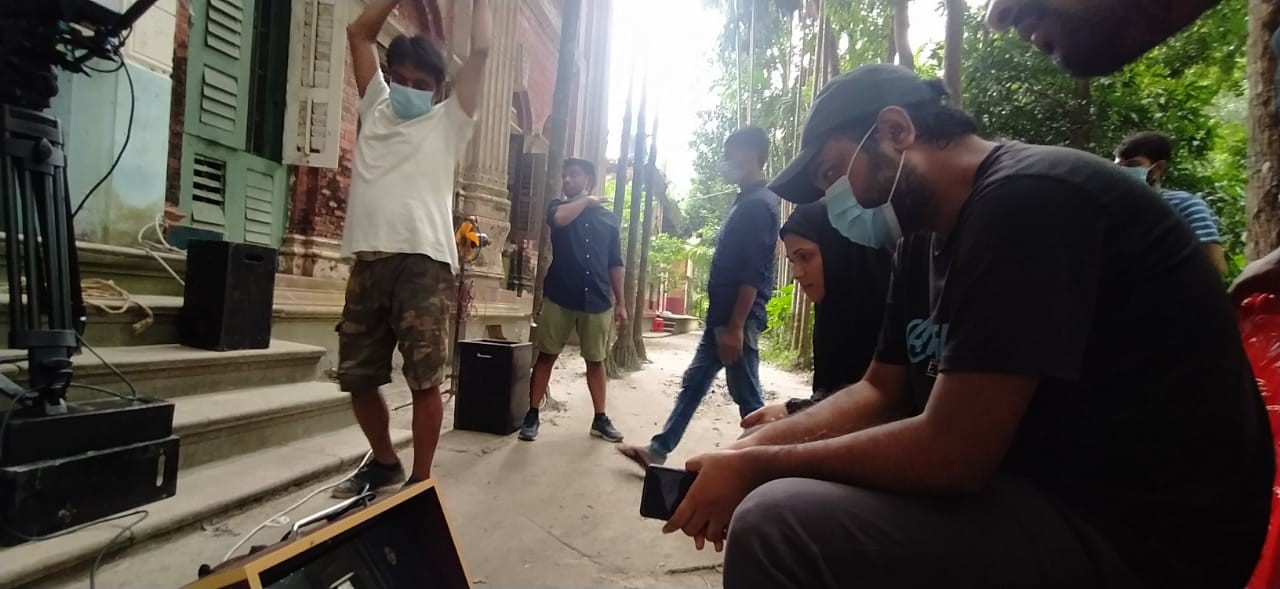Tell No Tales
.png)
CAT INDEX
CAT INDEX OVERVIEW
SCREENPLAY
MAKING
ACTING
Directed by Istiak Uddulah Pahlowan | Reviewed by Swastika Ghosh
Set in the present situation of Bangladesh, which is tumultuous and agitated at the core, the director’s intention to set a depressed and anxiety-ridden theme has been perfect. The film sets off its course at dawn which is extremely cold and silent, setting a dark tone for the audience. In the first scene of the film, the director shows an old metallic chain of a well, being drawn rather slowly. The slow movement is intentional, so as to not wake the neighbors. The director’s use of the raw, original sound of the chains clanking in the background is intended to provide the audience with an eerie feeling, setting a rather forbidding mood. Right after, we can see a man laying on the ground with a crutch beside him, probably unconscious, or dead. The man’s body is lying on a yard over a beautifully drawn alpona, a traditional folk art style of the Bengal region in India and Bangladesh, particularly drawn during festivities. We can see a dog sniffing and smelling the body, and eventually departing. I believe, this scene is the forbode of the entire film, where one's joy is the cause of another’s misery.
The dawn flowed into the morning when we can hear the morning Azaan, a religious prayer or announcement practiced in the Islamic community. We can see the protagonist, a 27-year-old man, Shams, lying in his bed with his wife, who suddenly raises his head and looks out the window after hearing a murmuring noise coming from outside. The man keeps checking for warning signs but finds nothing. This scene is extremely significant as it portrays the constant fear that the subordinates living in Bangladesh have to suffer every moment. The next scene is a wide shot where we find Shams on his way to someplace. Thereafter, a dilapidated mansion is shown, where a dog is the only living creature. In the following scene, the audience realizes that the dead man lying on the ground shown in the second scene is none other than the protagonist, Shams. This realization hits after we see the crutch in his hand while he struggles to climb the stairs in the old mansion. The struggle of men in Bangladesh is aptly represented through this minute-long, elaborate shot in a short nine-minute film.
The use of original sounds such as giggles and laughter of children while shooting the corridor of the mansion and the notes on a harmonium while showing an old, broken harmonium covered in dust and spiderweb exhibits a sense of longing and nostalgia through the protagonist’s eyes. These are two very significant shots wherein the director has tried and rather successfully portrayed the transitory nature of time. The lost days of youth accompanied by happiness and harmony are lost, and where the age of old and despaired, accompanied by terror, have settled. The director has constantly tried to keep the kernel theme consistent, that is the longing for peace and harmony. A few of the objects that keep appearing include musical instruments, a harmonium, and a do-tara, suggesting that Shams is a musician. In another scene, the background noise of riot and cacophony portrays Shams’ distraughtness while he struggles to pen down his thoughts on paper. At one point he seems to live like an inanimate object, deprived of his passion for art. Yet he keeps writing, for he is the activist who always takes a step forward. However, as fate breaks down upon him, we find him in shackles and eventually dead. The mansion, the stairs, and the chair, all long for his presence.
The absence of dialogue in the film is also indicative of the fact that freedom of speech is a distant dream in the country. However, the last scene of the film gives hope that one day the light will illuminate the darkness, and the old tea cups will witness the touch of warm lips and fulfilling conversations. The central and unifying themes of this experimental film include coming of age, followed by nostalgia, terror, and most importantly, despair. The compilation of short yet meaningful shots in the film aptly portrays the panic-stricken and anxious circumstances that Bangladesh is undergoing today. Given the circumstances, films such as these must be created but with utmost care to positively influence the audience who in turn will bring about a change in the societal constraints to restore peace and harmony.
 Swastika Ghosh was born in Kolkata and lives with her parents and her beloved dog, Fuss. She studied Linguistics at Jadavpur University, Kolkata, and holds immense love and passion for languages and literature. She spends much of her time indulging in contemporary and classic films from all across the globe.
Swastika Ghosh was born in Kolkata and lives with her parents and her beloved dog, Fuss. She studied Linguistics at Jadavpur University, Kolkata, and holds immense love and passion for languages and literature. She spends much of her time indulging in contemporary and classic films from all across the globe.





